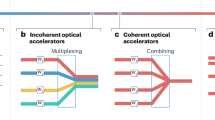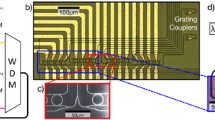
Overview
- Offers novel multidisciplinary viewpoints on photonic neural networks
- Covers both mathematical models and physical implementation of photonic neural networks
- This book is open access, which means that you have free and unlimited access
- Written by experts in nonlinear mathematical science, information photonics & integrated systems engineering
Buy print copy
Tax calculation will be finalised at checkout
About this book
This open access book presents an overview of recent advances in photonic neural networks with spatiotemporal dynamics. The computing and implementation paradigms presented in this book are outcomes of interdisciplinary studies by collaborative researchers from the three fields of nonlinear mathematical science, information photonics, and integrated systems engineering. This book offers novel multidisciplinary viewpoints on photonic neural networks, illustrating recent advances in three types of computing methodologies: fluorescence energy transfer computing, spatial-photonic spin system, and photonic reservoir computing.
The book consists of four parts: Part I introduces the backgrounds of optical computing and neural network dynamics; Part II presents fluorescence energy transfer computing, a novel computing technology based on nanoscale networks of fluorescent particles; Parts III and IV review the models and implementation of spatial-photonic spin systems and photonic reservoir computing, respectively.
These contents are beneficial to researchers in a broad range of fields, including information science, mathematical science, applied physics, and engineering, to better understand the novel computing concepts of photonic neural networks with spatiotemporal dynamics.Similar content being viewed by others
Keywords
Table of contents (13 chapters)
-
Front Matter
-
Introduction
-
Front Matter
-
-
Fluorescence Energy Transfer Computing
-
Front Matter
-
-
Photonic Reservoir Computing
-
Front Matter
-
Editors and Affiliations
About the editors
Hideyuki Suzuki received the B.S. degree in mathematics, and the M.E. and Ph.D. degrees in mathematical engineering from the University of Tokyo in 1996, 1998 and 2001, respectively. He is currently a Professor in the Graduate School of Information Science and Technology at Osaka University. His current research interests include nonlinear dynamics and its applications.
Jun Tanida received the B.E., M.E., and Ph.D. degrees in applied physics from Osaka University in 1981, 1983, and 1986, respectively. He is currently a Professor in the Graduate School of Information Science and Technology at Osaka University. His current research interests include information photonics, computational imaging, and photonic DNA computing.
Masanori Hashimoto received the B.E., M.E., and Ph.D. degrees in communications and computer engineering from Kyoto University in 1997, 1999, and 2001, respectively. He is currently a Professor in the Department of Informatics at Kyoto University. His current research interests include the design for manufacturability and reliability, soft error characterization, timing and power integrity analysis, reconfigurable computing, and low-power circuit design.
Bibliographic Information
Book Title: Photonic Neural Networks with Spatiotemporal Dynamics
Book Subtitle: Paradigms of Computing and Implementation
Editors: Hideyuki Suzuki, Jun Tanida, Masanori Hashimoto
DOI: https://doi.org/10.1007/978-981-99-5072-0
Publisher: Springer Singapore
eBook Packages: Computer Science, Computer Science (R0)
Copyright Information: The Editor(s) (if applicable) and The Author(s) 2024
Hardcover ISBN: 978-981-99-5071-3Published: 17 October 2023
Softcover ISBN: 978-981-99-5074-4Published: 17 October 2023
eBook ISBN: 978-981-99-5072-0Published: 16 October 2023
Edition Number: 1
Number of Pages: VIII, 278
Number of Illustrations: 20 b/w illustrations, 108 illustrations in colour
Topics: Artificial Intelligence, Mathematical Models of Cognitive Processes and Neural Networks, Applications of Nonlinear Dynamics and Chaos Theory



